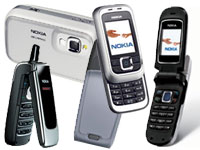Nokia unveils seven new handsets


Only six weeks after introducing its N-Series line of phones, Nokia launched seven new handsets at its annual Nokia Connection event in Singapore today. The new additions include a WCDMA model (Nokia 6280), three GSM handsets (Nokia 6060,6111, 6270) and three CDMA phones (Nokia 2125, 2255, 6265).
The new additions to the Nokia family cater for the entry- to mid-level market and include candybar phones, stylish clamshells and slider models.
First up is the most compact of the group, the Nokia 6111. A cute triband GSM phone with a concealed keypad that slides down, it is reminiscent of the Siemens SL65 and Samsung's E800. Weighing a mere 92g and measuring 84 x 47 x 23mm, the tiny 6111 features a one-megapixel camera, MP3/AAC ring tones, Bluetooth, USB connectivity and a 262K-colour screen. Two colour choices are available: Pearl White & Silver or Black & Silver.
Next in the showcase was Nokia's 6060, a sophisticated looking flip phone with a chrome and high-gloss finish featuring a pulsating light strip on the front to indicate incoming calls and messages. It also weighs 92g, has a 65K-colour screen and is the only phone announced that has an external antenna. Additional features include an xHTML browser, e-mail, MP3 ring tones and MMS, although there is no built-in camera to take pictures.
Joining the recently revealed N70, the N90 and the N91 in 2-megapixel prowess is Nokia's 6270 and 6280. These two handsets are very similar and both feature a slide-up design, MP3 playback and a 2.2-inch screen capable of displaying 262K colours. The 6270 is a quad-band GSM model, whereas the 6280 is 3G capable.
Nokia also took the wraps off another 2-megapixel camera phone with a slide-up design, the 6265, which works on CDMA networks. It has similar specs to the other 6000 series phones announced and includes an SD mini card slot to store music, photos and video.
All of the camera phones have dedicated shutter keys on their sides, which allow pictures to be taken in landscape mode, similar to regular cameras.
Many of the handsets feature a new spiced up interface that allows you to customise the home page with icon-based shortcuts for frequently used applications, calendar events such as meetings and tasks, and shortcuts to play music. The menu has also been changed to an icon-based grid, an easy-to-use feature found on many Sony Ericsson handsets. While the trend has been for Nokia use the Symbian-based Series 60 platform on its 3G handsets (with the exception of the 7600), the new interface is for Series 40 phones and it will be implemented on all of the new 6xxx models, including the 3G capable 6280.
The Finnish phone giant also released two entry-level CDMA handsets, the Nokia 2125 and the 2255.
According to analyst firm IDC, Nokia held 72% of the converged mobile device market in Australia in 2004, a figure the company hopes to grow though the mainstream adoption of 3G.
At the opening of the Nokia connection event, which is a precursor to Singapore's large telecommunications conference CommunicAsia, Senior Vice President for Nokia's Asia-Pacific customer and market operations Urpo Karjalainen said that the recent release of the 3G-enabled N-Series devices coupled with the mainstream 6280 will encourage 3G services for Australia, Singapore and Malaysia.
"The industry is now in the midst of a major transition, with the key drivers being convergence, IP and the take off of WCDMA. I am confident that the high performance multimedia devices will help drive the uptake of 3G further in these markets," Karjalanen said.
According to the Finnish-based company, the number of mobile phone subscribers at the end of 2004 was 1.7 billion, which Nokia expected will hit 3 billion by 2010. Senior Vice President of Nokia Networks, Rajeev Suri, emphasised that the Asia-Pacific region will account for half of this growth, with the most potential for expansion expected in India, Indonesia and Vietnam.
Model
| Network | Availability | Features |
| CDMA | Q3, 2005 | Entry-level handset, 65K-colour display, flashlight, speakerphone, 85 grams, CDMA 1X up to 153.6kbps download speed, interchangeable Xpress-on covers. |
| CDMA | Q3, 2005 | Entry-level flip phone, 128x128-pixel screen, 64K colours, FM radio, Games: Cricket, Soccer, Snake Xenzia and Stair Ball, spreadsheet application. |
| GSM | Q3, 2005 | Mid-range dual-band flip phone, chrome and high-gloss case, MP3 ring tones, pulsating call indicator, e-mail, xHTML browser, MMS. |
| GSM | Q4, 2005 | 1-megapixel camera, MP3/AAC ring tones, push to talk, Bluetooth, Infrared, xHTML browser, FM radio with Visual Radio client, slide-up design. |
| CDMA | Q4, 2005 | 2-megapixel camera, 262K-colour screen, CDMA 1X for speeds up to 153.6kbps, MiniSD card slot, Bluetooth, USB, Infrared, slide-up design. |
| GSM | Q4, 2005 | 2-megapixel camera with flash, quad-band, MP3/AAC player, Bluetooth, 128MB miniSD card, direct photo printing via USB, PC synchronisation, slide-up design. |
| WCDMA | Q4, 2005 | 2-megapixel camera, second VGA camera for 3G video calls, MP3 player, Bluetooth, Infrared, e-mail with attachment support (JPEG, PDF, DOC, XLS, PPT), new Series 40 interface, FM radio, 64MB mini SD memory card, PC synchronisation, slide-up design. |
Jeremy Roche travelled to Singapore as a guest of Nokia.